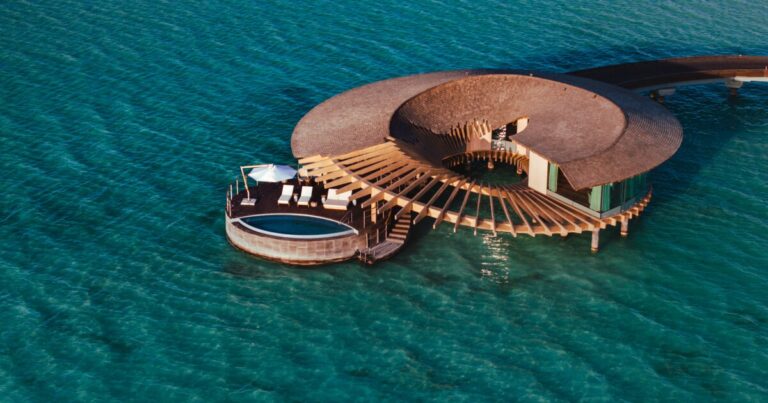In the field of innovative architecture, few projects can match Umahat Al-Sheikh Island for sheer ambition and environmentally conscious design. The project, led by architect Kengo Kuma and his team, is a triumph of sustainability and luxury tourism in the heart of the Red Sea.
The Umahat Al Sheikh Island Project consists of 22 islands located on the west coast of Saudi Arabia, and its design philosophy is deeply rooted in environmental considerations. This ambitious master-planned zone is surrounded by more islands, miles of vast desert and dramatic volcanic landscapes, and development company Red Sea Global (formerly TRSDC) has announced that one of the project’s islands will be commissioned Kengo Kuma to design luxury tourist villas and other buildings.
Mr. Kuma and his team chose a site-specific approach, creating a low, horizontal “land villa” with a gently curved roof that mimics the natural contours of the surrounding sand dunes. The design of the villa not only ensures guest privacy, but also minimizes sand inflow to maintain the island’s shape. Additionally, taking cues from coral ecosystems, the offshore sea villa boasts a spiral structure that emerges from the ocean, offering guests stunning views across the ocean.

A spiral structure emerges from the sea, offering stunning views of the water’s edge.
Kengo Kuma Architects and Urban Design Office
“Our design approach to the Umahat Al-Sheikh Island project is deeply rooted in the unique characteristics of the site and fosters a philosophy of seamless integration with the surrounding landscape,” said Kengo Kuma & Associates. speaks. “Despite the challenges posed by the delicate environment, our site-specific approach guided us to build. [the Land Villas]. ”
To build the resort, Kuma chose to use sustainable alternatives to traditional construction materials and methods. To minimize the use of concrete and reduce the project’s environmental footprint, a prefabricated system utilizing primarily spruce wood and clay plaster was employed. The roof is covered with natural cedar shingles, which are specially selected for their resistance to harsh weather conditions and salt water.

Villa design minimizes sand filling to ensure guest privacy and maintain the shape of the island
Kengo Kuma Architects and Urban Design Office
Shade and ventilation are also very important in a climate like Umahut. So the architects created large cantilevered roofs for all residences to maximize the area of shade throughout the day.
Additionally, Kuma and his team have been proactive in preserving the environment by designing buildings that can be disassembled and removed without causing significant damage to the environment. Prefabrication methods played a vital role in achieving this goal, minimizing disruption to the island’s delicate ecosystem.
As part of the Uma Hut 9-3 project, Kuma and his firm also designed two specialty restaurants, one on land and one on the water. Community building. spa; reception pavilion; Housekeeping villa. and a guest pier.

Villa design minimizes sand filling to ensure guest privacy and maintain the shape of the island
Kengo Kuma Architects and Urban Design Office
Beyond its architectural and environmental achievements, the Umahat Al-Shaikh Island project has broader significance within the context of Saudi Arabia’s Vision 2030 initiative. As part of this ambitious plan to diversify the country’s economy, this project represents a forward-thinking approach to sustainable development and tourism.
Source: KKAA

